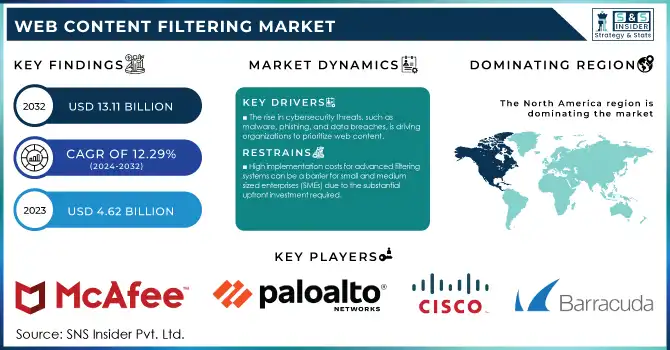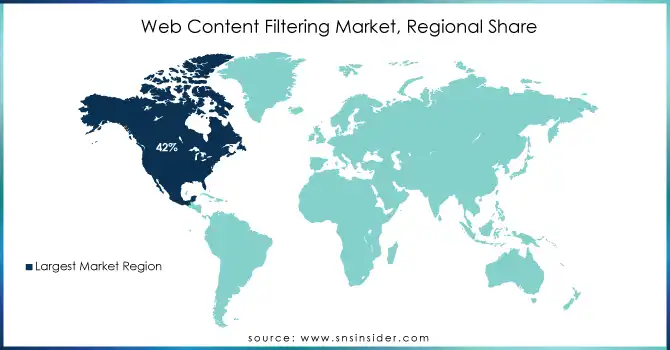WEB CONTENT FILTERING MARKET REPORT SCOPE & OVERVIEW:

To get more information on Web Content Filtering Market - Request Free Sample Report
The Web Content Filtering Market size was valued at USD 4.62 Billion in 2023 and is expected to reach USD 13.11 Billion by 2032 and grow at a CAGR of 12.29% over the forecast period 2024-2032.
The Web Content Filtering Market is witnessing significant growth, driven by increasing concerns over cybersecurity and the need for robust online safety measures. Organizations across industries are prioritizing web content filtering solutions to protect against cyber threats, ensure regulatory compliance, and maintain workplace productivity. The rise in remote work and hybrid workplace models has further amplified the demand for these solutions, as businesses aim to secure access to sensitive data and restrict inappropriate or harmful content. Key trends shaping the market include the integration of artificial intelligence (AI) and machine learning (ML) into web filtering systems, enabling real-time threat detection and enhanced accuracy in identifying malicious content. AI-driven solutions are particularly effective in adapting to evolving cyber threats and reducing false positives, making them a preferred choice for enterprises. Additionally, the growing adoption of cloud-based content filtering solutions is notable. Cloud deployment offers scalability, ease of management, and cost efficiency, which are essential for small and medium-sized businesses (SMBs) and large enterprises alike.
Another significant trend is the emphasis on employee monitoring and content regulation in workplaces. Organizations are leveraging web content filtering tools to strike a balance between enabling access to essential resources and preventing misuse of internet privileges. This has also led to the emergence of tailored solutions designed for specific industries, such as education and healthcare, where content regulation is critical for protecting sensitive information and adhering to stringent compliance requirements.
MARKET DYNAMICS:
DRIVERS
-
The rise in cybersecurity threats, such as malware, phishing, and data breaches, is driving organizations to prioritize web content
The growing prevalence of cybersecurity threats, including malware, phishing attacks, and data breaches, is driving the adoption of web content filtering solutions across industries. Organizations face an increasing number of sophisticated cyberattacks that exploit unsecured web access, making robust filtering systems a critical component of their cybersecurity strategy. Web content filtering acts as a frontline defense by restricting access to malicious or inappropriate websites, preventing the infiltration of harmful content, and protecting sensitive data.
As cybercriminals continue to evolve their tactics, organizations are under pressure to stay ahead by investing in advanced filtering tools that can adapt to new threats in real time. The rise in remote work and bring-your-own-device (BYOD) policies has further heightened the need for solutions capable of safeguarding networks beyond traditional office environments. Industries such as finance, healthcare, and education are particularly vulnerable due to the sensitive nature of their data, and they are increasingly relying on web content filtering to ensure compliance with stringent regulations and mitigate risks.
RESTRAIN
-
High implementation costs for advanced filtering systems can be a barrier for small and medium-sized enterprises (SMEs) due to the substantial upfront investment required.
The high implementation costs associated with deploying advanced web content filtering systems can be a significant barrier, particularly for small and medium-sized enterprises (SMEs). While these solutions are crucial for safeguarding networks and ensuring regulatory compliance, the initial investment required can be substantial. The cost involves not only purchasing the filtering software or hardware but also the integration, maintenance, and potential training required for employees to effectively use the system. For SMEs with limited budgets, these expenses can present a significant challenge, as they may not have the financial resources to allocate to such investments.
Furthermore, advanced filtering solutions often require continuous updates to stay ahead of evolving cyber threats, which adds to the ongoing operational costs. This is particularly relevant in industries such as healthcare and finance, where compliance and security are critical. Although cloud-based solutions have emerged as a cost-effective alternative due to their scalability and subscription-based models, the overall expense can still be a hurdle for smaller businesses.
KEY SEGMENTATION:
By Component
The solutions segmentation dominated with the market share over 68% in 2023, capturing the largest share due to the rising need for comprehensive security measures to block malicious content, safeguard sensitive data, and regulate internet usage within organizations. This segment includes software tools and filtering systems that proactively block harmful websites, ensuring that networks remain secure. Solutions offer a more scalable and effective approach compared to services, allowing businesses to customize filtering capabilities to meet their specific needs. The demand for these solutions is particularly high across industries like education, government, and enterprises, where safeguarding data and maintaining productivity are priorities.
By Deployment
On-premises segment dominated with the market share over 64% in 2023, particularly in industries where data privacy, security, and compliance are critical. By hosting filtering solutions internally, organizations gain full control over their infrastructure and data, ensuring that sensitive information remains within their secured environment. This is especially important for sectors such as healthcare, finance, and government, where regulatory requirements and the risk of data breaches are of utmost concern. On-premises solutions enable these industries to customize filtering policies to meet specific needs, maintain direct oversight, and avoid the potential risks associated with storing data on external servers.
KEY REGIONAL ANALYSIS:
North America region dominated with the market share over 42% in 2023, due to several key factors. The region has seen widespread adoption of advanced cybersecurity measures as businesses and institutions prioritize securing their digital environments from cyber threats. Stringent government regulations, such as data privacy laws and compliance requirements, further fuel the demand for web content filtering solutions to ensure adherence to these standards. Additionally, North America is home to several leading market players in cybersecurity and web filtering technologies, which contribute to the region’s dominance. The presence of large-scale enterprises and high internet penetration also plays a significant role in the adoption of web content filtering solutions.
Asia-Pacific is the fastest-growing region in the Web Content Filtering Market, driven by rapid digital transformation across various industries. With increasing internet penetration, more individuals and businesses in the region are becoming connected, creating a higher demand for cybersecurity solutions to protect against online threats. Countries like India, China, and Southeast Asia are experiencing significant growth in internet usage, particularly with mobile devices, which further accelerates the need for web content filtering technologies. Moreover, rising awareness about the importance of cybersecurity and data protection is pushing organizations and governments in these emerging economies to adopt such solutions.

Do You Need any Customization Research on Web Content Filtering Market - Enquire Now
KEY PLAYERS:
Some of the major key players of Web Content Filtering Market
-
McAfee Inc. (McAfee Web Gateway, Cloud Secure Web Gateway)
-
Blue Coat Systems Inc. (Blue Coat WebFilter, ProxySG)
-
Palo Alto Networks Inc. (URL Filtering, PAN-DB)
-
Cisco Systems Inc. (Cisco Umbrella, Web Security Appliance)
-
Barracuda Networks Inc. (Barracuda Web Security Gateway, Web Application Firewall)
-
ContentKeeper Technologies (ContentKeeper Secure Internet Gateway)
-
Bloxx, Ltd. (Bloxx Web Filtering)
-
Fortinet (FortiGuard Web Filtering, FortiGate)
-
Interoute (Interoute Secure Web Gateway)
-
TitanHQ (WebTitan Cloud, WebTitan Gateway)
-
Clearswift (Clearswift Secure Web Gateway)
-
Cyren (Cyren Web Security)
-
Trend Micro (Trend Micro InterScan Web Security, Cloud App Security)
-
Untangle (NG Firewall Web Filter, Command Center)
-
Symantec Corporation (Symantec WebFilter, ProxySG)
-
Kaspersky Lab (Kaspersky Web Traffic Security, Endpoint Security)
-
Zscaler Inc. (Zscaler Internet Access, Zscaler Secure Web Gateway)
-
Sophos (Sophos XG Firewall, Web Gateway)
-
Forcepoint LLC (Forcepoint Web Security Cloud, NGFW)
-
WatchGuard Technologies Inc. (WatchGuard WebBlocker, Firebox Security Suite)
Suppliers (Leader in advanced threat protection and policy-driven web filtering) Web Content Filtering Market
-
Cisco Systems, Inc.
-
Symantec (Broadcom Inc.)
-
Fortinet, Inc.
-
Trend Micro Incorporated
-
McAfee, LLC
-
Palo Alto Networks, Inc.
-
Forcepoint LLC
-
Zscaler, Inc.
-
Sophos Group plc
-
Barracuda Networks, Inc.
RECENT DEVELOPMENT:
In January 2024: Trend Micro enhanced its web filtering solution with advanced AI capabilities to better detect and block online threats. This update strengthens protection against evolving cyber risks driven by the widespread adoption of AI technologies.
In November 2024: AWS launched a web filtering solution for educational institutions, leveraging AWS Network Firewall to block access to inappropriate content and enhance online safety. This system allows administrators to customize filtering policies and manage traffic flow to ensure a secure learning environment.
| Report Attributes | Details |
|---|---|
|
Market Size in 2023 |
USD 4.62 Billion |
|
Market Size by 2032 |
USD 13.11 Billion |
|
CAGR |
CAGR of 12.29% From 2024 to 2032 |
|
Base Year |
2023 |
|
Forecast Period |
2024-2032 |
|
Historical Data |
2020-2022 |
|
Report Scope & Coverage |
Market Size, Segments Analysis, Competitive Landscape, Regional Analysis, DROC & SWOT Analysis, Forecast Outlook |
|
Key Segments |
• By Component (Solutions, Services) |
|
Regional Analysis/Coverage |
North America (US, Canada, Mexico), Europe (Eastern Europe [Poland, Romania, Hungary, Turkey, Rest of Eastern Europe] Western Europe] Germany, France, UK, Italy, Spain, Netherlands, Switzerland, Austria, Rest of Western Europe]), Asia Pacific (China, India, Japan, South Korea, Vietnam, Singapore, Australia, Rest of Asia Pacific), Middle East & Africa (Middle East [UAE, Egypt, Saudi Arabia, Qatar, Rest of Middle East], Africa [Nigeria, South Africa, Rest of Africa], Latin America (Brazil, Argentina, Colombia, Rest of Latin America) |
|
Company Profiles |
McAfee Inc., Blue Coat Systems Inc., Palo Alto Networks Inc., Cisco Systems Inc., Barracuda Networks Inc., ContentKeeper Technologies, Bloxx Ltd., Fortinet, Interoute, TitanHQ, Clearswift, Cyren, Trend Micro, Untangle, Symantec Corporation, Kaspersky Lab, Zscaler Inc., Sophos, Forcepoint LLC, WatchGuard Technologies Inc. |
|
Key Drivers |
•The rise in cybersecurity threats, such as malware, phishing, and data breaches, is driving organizations to prioritize web content |
|
RESTRAINTS |
• High implementation costs for advanced filtering systems can be a barrier for small and medium-sized enterprises (SMEs) due to the substantial upfront investment required. |

